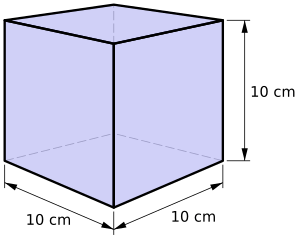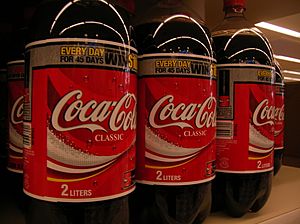Litre facts for kids
A litre (pronounced "LEE-ter") is a common unit for measuring volume in the metric system. It's how we measure liquids like milk, juice, or soda. In the United States, it's spelled "liter."
One litre is the same amount of space as a cube that is 10 centimetres long, 10 centimetres wide, and 10 centimetres tall. This is also called a cubic decimetre.
Did you know that one litre of water weighs almost exactly one kilogram? This was part of how the litre was first defined a long time ago!
The symbol for litre can be "L" or "l". Many people prefer to use the capital "L" because the small "l" can sometimes look like the number "1".
Contents
Smaller Units of a Litre
For measuring smaller amounts of liquid, we use parts of a litre:
- A decilitre (dl) is one-tenth of a litre. So, 10 decilitres make one litre.
- A centilitre (cl) is one-hundredth of a litre. So, 100 centilitres make one litre.
- A millilitre (ml) is one-thousandth of a litre. So, 1,000 millilitres make one litre.
Litre Conversions
Sometimes you might see litres compared to other units of volume, like gallons.
And the other way around:
- 1 imperial gallon is about 4.55 litres.
- 1 US gallon is about 3.79 litres.
History of the Litre
The metric system was first created in France in 1791. At first, it didn't have a special unit just for volume. People were supposed to use cubic metres.
However, a cubic metre is very large! Imagine a cube that's one metre tall, one metre wide, and one metre deep. That's a lot of space! People needed a smaller unit for everyday things.
So, in 1793, a new unit was suggested. It was based on an old French unit called the "cadil." This new unit was meant to be 0.001 cubic metres. This was the same size as a cube with sides of 10 centimetres. This unit was also known as the "pinte" or "litron."
In 1795, this new unit was officially named the litre.
How the Litre's Definition Changed
In 1795, the kilogram was defined as the mass of exactly one litre of water at 4 °C (which is when water is densest).
Later, in 1901, scientists measured the volume of one kilogram of water at 4 °C very carefully. They found it was slightly different from a perfect cubic decimetre. So, they decided to redefine the litre to be exactly the volume of one kilogram of water at 4 °C.
Then, in 1960, the SI (the modern metric system) was introduced. The people in charge, the BIPM, changed the definition of the litre again. They said it was exactly "one cubic decimetre" (1 dm3).
The litre is not an official SI unit itself, but it's "accepted for use with the SI" because it's used so much around the world. They also said it shouldn't be used for super-accurate scientific work.
Why Two Symbols?
According to SI rules, units named after people get a capital letter symbol (like "N" for Newton). Units not named after people get a small letter symbol (like "m" for metre). Since "litre" isn't named after a person, its symbol should be "l".
But, as we mentioned, the small "l" can easily look like the number "1". To avoid confusion, in 1979, the BIPM made an exception. They said that both "L" and "l" are allowed as symbols for the litre.
Images for kids
-
One-litre beer mugs (German: Maßkrüge) at the 2006 Oktoberfest in Germany
See also
 In Spanish: Litro para niños
In Spanish: Litro para niños





